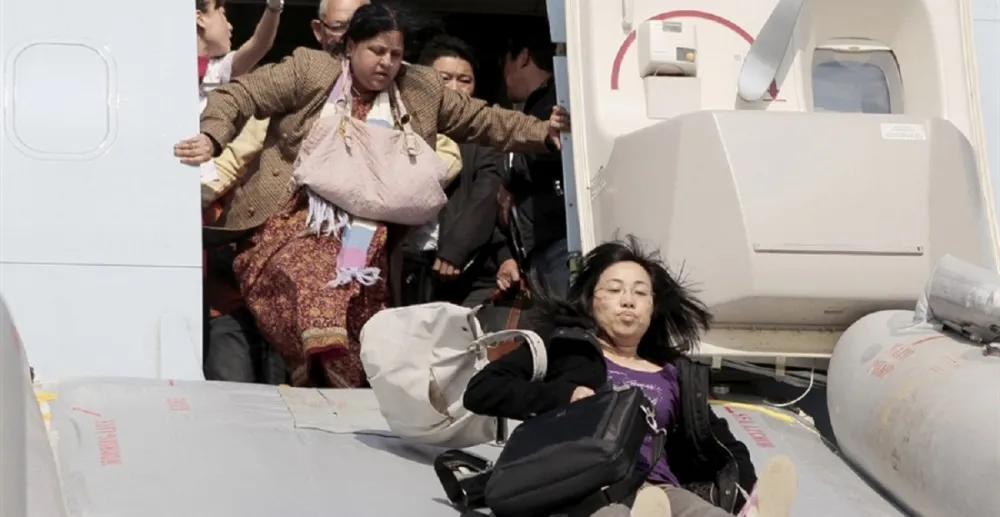
Economy airfares could double if passenger evacuation standards increase
Sep 23, 2020

Recent analyses indicate that the cost of economy airfares may rise significantly if regulations surrounding passenger evacuation standards are tightened. Enhanced safety protocols, aimed at improving emergency exit procedures and overall passenger safety, would likely require airlines to invest in aircraft modifications and additional training for crew members. These changes could lead to increased operational costs, which airlines might pass on to consumers through higher ticket prices. As a result, travelers could face a substantial financial burden, potentially doubling the cost of economy tickets, altering the dynamics of air travel accessibility for many.
As the aviation industry evolves, the dynamics of airfares are continuously influenced by various factors, including regulatory changes. One significant area of concern is the potential increase in "passenger evacuation standards", which could lead to a substantial rise in "economy airfares". In this article, we will explore how these changes could impact ticket prices and analyze the implications for travelers and the airline industry.
Understanding Passenger Evacuation Standards
Passenger evacuation standards are designed to ensure the safety of travelers during emergencies. These regulations dictate how quickly and efficiently passengers can be evacuated from an aircraft in the event of an emergency. As safety becomes a top priority in the aviation industry, regulatory bodies are continually reviewing and updating these standards.
Recent discussions have suggested that stricter evacuation standards may be on the horizon. Such changes could require airlines to modify aircraft designs, increase crew training, and enhance evacuation equipment. While these measures are essential for passenger safety, they come at a cost.
The Financial Implications of Stricter Standards
The potential increase in costs associated with heightened evacuation standards could have a direct impact on "economy airfares". Airlines may need to invest significantly in new technologies, training programs, and operational procedures to comply with stricter regulations. These investments are likely to be passed on to consumers in the form of higher ticket prices.
According to industry experts, if "passenger evacuation standards" were to increase, it’s conceivable that "economy airfares" could double. This dramatic shift would not only affect the affordability of air travel but also reshape consumer behavior and travel habits.
Chart: Projected Increase in Economy Airfares
| Year | Current Average Economy Fare | Projected Average Economy Fare (with increased standards) |
|---|---|---|
| 2023 | $250 | $250 |
| 2024 | $250 | $300 |
| 2025 | $250 | $375 |
| 2026 | $250 | $500 |
Impact on Travelers
The potential doubling of "economy airfares" could have far-reaching effects on travelers. For many individuals and families, air travel is already a significant expense. Increased ticket prices may deter some from flying altogether, leading to a decline in air travel demand.
In response to higher fares, travelers may seek alternative modes of transportation, such as trains or buses, or they may choose to vacation closer to home. This shift could result in a decrease in revenue for airlines, creating a paradox where the need for safety standards ultimately harms the very industry they aim to protect.
Airline Industry Responses
As airlines grapple with the financial implications of increased evacuation standards, many may explore various strategies to mitigate costs. These could include:
- Streamlining operations to reduce overhead costs.
- Investing in more fuel-efficient aircraft to lower operational expenses.
- Implementing dynamic pricing strategies to manage demand and maximize revenue.
Moreover, airlines may also enhance their marketing efforts to emphasize the safety benefits associated with higher standards. By positioning themselves as leaders in passenger safety, airlines could potentially justify higher fares to consumers who prioritize safety over cost.
Conclusion
In summary, the potential increase in "passenger evacuation standards" poses a significant challenge for the aviation industry. While these standards are crucial for ensuring passenger safety, they could lead to a doubling of "economy airfares", drastically affecting travel accessibility.
Travelers, airlines, and regulators must work collaboratively to strike a balance between safety and affordability. As the industry evolves, ongoing dialogue and innovation will be essential in navigating the complexities of air travel in a changing regulatory landscape.
Ultimately, the future of "economy airfares" will depend on how effectively the industry adapts to these challenges while maintaining a commitment to passenger safety and satisfaction.
Related Articles

Explore Thailand: The Best Islands to Visit for Paradise, Adventure, and Relaxation

The Ultimate Guide to the Best Islands in Thailand for Your Next Getaway

Do babies need passports? How to get a passport for a newborn

How to get a U.S. passport fast: here’s how to expedite the process

What is Mobile Passport Control: 5 reasons why you should use it

SENTRI vs. Global Entry: A detailed guide

Do you need a passport to go to the Bahamas? Let’s find out

Do you need a passport to go to Mexico? A detailed guide

Do you need a passport to go to Canada? We got the answer

Do You Need a Passport for a Cruise: An Essential Travel Guide

Booster Seat Requirements: All the Rules to Follow in Your Rental Car

What Are the World’s Most Powerful Passports, and How Does Yours Rank?

How to Take a Passport Photo at Home: A Helpful Guide

You've got to have heart! Southwest's new livery

Your opinion: Should water be free on low cost carriers?

Young women bolder than guys as solo travellers
